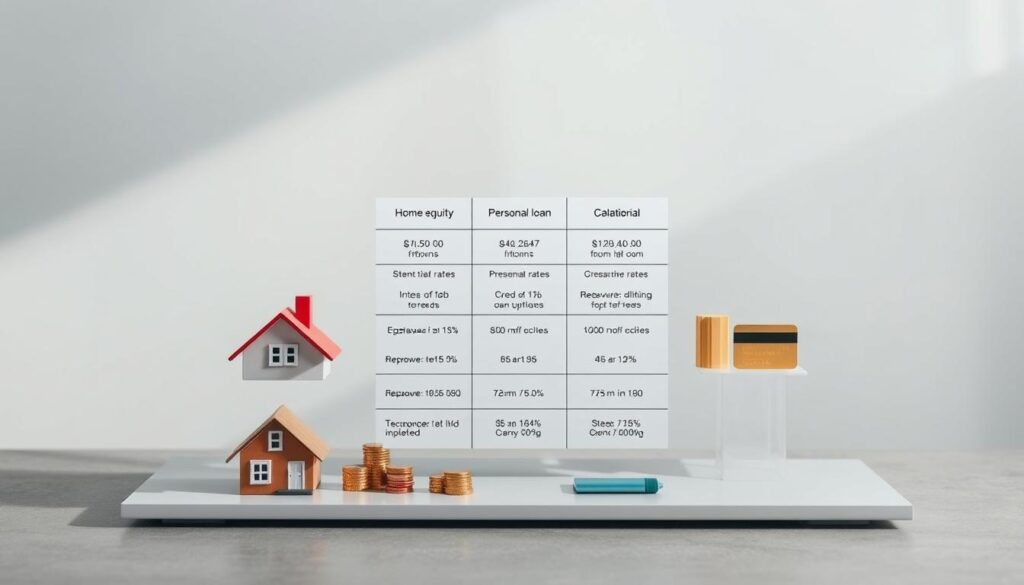Did you know U.S. homeowners hold over $10 trillion in untapped home equity? That’s enough to fund kitchen, bathroom, and backyard makeovers across the country. With home values rising and homes scarce, your home’s equity could fund your dream renovations without using credit cards.
Rising property prices mean many Americans now have more home equity than ever. Instead of letting it sit idle, home equity investment loans can turn it into cash. This cash can fund projects that improve comfort and increase your home’s value. This guide will show you how these loans can help, from kitchen remodels to outdoor living spaces.
What Are Home Equity Investment Loans?
Home equity investment loans let you use your home’s value for projects like kitchen upgrades. They use your home’s equity as collateral. This is different from other loans because they have terms made for renovation goals.
Definition and Overview
A home equity loan gives you a lump sum based on your home’s equity. Lenders look at your home’s value and your financial health to decide how much you can borrow. You’ll have fixed repayment schedules, so your monthly payments will be the same.
How They Differ from Traditional Home Equity Loans
- Interest Rates: Often lower than credit cards or personal loans.
- Structure: Offer a one-time payout vs. revolving credit lines like HELOCs.
- Risk: Your home secures the loan, so late payments could lead to foreclosure.
These loans are great for homeowners who want to improve their space without financial stress. Always compare them with traditional home equity loan options to find the best one for you.
Benefits of Using Home Equity Investment Loans
Home equity investment loans are smart renovation financing options. They let you use your home’s value for projects. This way, you get benefits that other loans can’t offer.
Flexible Financing Options
These loans fit your budget for any project. You can pick a fixed-rate loan for specific updates or a HELOC for ongoing renovation financing. This flexibility helps you manage payments for any size of project.
Low Interest Rates
- Home equity loans have interest rates between 4-7%, lower than credit cards (15-20%) or personal loans (10%).
- With these low rates, you save money. This means you can invest in better materials and skilled workers.
Increased Home Value
Smart renovations can increase your home’s value by up to 70% of the cost. For example:
- Kitchens: A $25,000 kitchen update can add $20,000+ to your home’s value.
- Bathrooms: A new master bath can increase your home’s value by $10,000.
These benefits make home equity loans a wise long-term choice. By using your home’s equity, you turn remodeling dreams into valuable assets that grow over time.
How to Qualify for a Home Equity Investment Loan
To get a home equity loan for home improvements, lenders check certain things. Here’s what you need to qualify:
Credit Score Requirements
- Lenders usually want a credit score of at least the mid-600s.
- Higher scores mean better interest rates and loan terms.
Income Verification
- You must show steady income, with a debt-to-income (DTI) ratio under 43%.
- Pay stubs and tax returns help lenders see if you can repay the loan.
Home Appraisal Process
An appraiser checks your home’s current value. This figure shows how much equity you can use. For example, if your home is worth $300,000 and you owe $150,000, you can borrow up to 85% of $300,000 minus your remaining loan. Learn more about eligibility here.
Lenders follow these steps to make sure you can handle the loan. Work on your credit, keep your income steady, and get ready for the appraisal. This will help you get the best loan for your home improvements.
Comparing Home Equity Investment Loans to Other Financing Methods
Choosing the right financing for your renovation is key. You should compare equity investment options with other loans. Let’s look at the differences between home equity loans, personal loans, and credit cards. Knowing these options helps you find the best fit for your budget and goals.

Conventional Home Renovation Loans
Traditional home renovation loans have fixed interest rates based on your credit score. They are secured by your home but may require higher down payments or stricter income checks. Equity investment options usually offer better rates since they use your home’s value as collateral.
Personal Loans
Personal loans don’t use your home as security, which lowers risk but raises interest rates. They offer smaller loan amounts, making them better for minor projects rather than major renovations.
Credit Cards
Credit cards offer flexibility but charge high APRs, often over 15%. They lack the large funding needed for renovations, making them a less practical choice compared to equity investment options.
Equity investment options stand out with lower interest rates and larger funding limits. They’re ideal if you have enough home equity. Weigh these factors carefully to avoid overextending your budget or risking your property.
Understanding the Risks Involved
Before you get a home renovation loan, it’s important to know the risks. Loans tied to your home’s value can be tricky. Unexpected market changes or extra costs can hurt your finances. Here are some things to watch out for:
- Market Fluctuations: Home prices can go up or down. If prices drop, your equity goes down. This means you might have less to use for future loans or owe more than your home is worth.
- Equity at Risk: Taking out a loan means you own less of your home. If your home’s value falls below the loan amount, you could still owe money after selling.
- Hidden Costs: There are extra costs like closing fees, appraisal fees, and interest. These costs can add up. They are common with most home renovation loans.
Keep an eye on local housing trends and talk about fees with lenders. This way, you can avoid surprises. Home renovation loans are flexible, but it’s crucial to plan carefully.
Identifying Suitable Home Renovation Projects
Maximizing property value investment begins with picking projects that make a big difference. Look for upgrades that attract buyers and increase your home’s value. Here are three key areas to focus on:
Kitchen Remodels
- Update cabinets, countertops, and appliances to match today’s trends.
- Open layouts and smart storage systems make your kitchen more appealing. HEIexplained says these changes can return up to 85% of your investment.
Bathroom Upgrades
Give bathrooms a makeover with walk-in showers, new vanities, and energy-saving fixtures. A modern bathroom can add over $10,000 to your home’s value. It’s a wise property value investment.
Outdoor Spaces
Turn patios or decks into extra living areas. Add landscaping with plants that don’t need much water to improve your home’s look. Outdoor kitchens or fire pits can also increase your home’s value and enjoyment.
Choose timeless designs over trendy ones. Use high-quality materials and hire skilled professionals for the best results. Every dollar you spend here can help your home sell for more in the future.
Calculating Potential Return on Investment
When upgrading your home, it’s key to know your return on investment (ROI). This helps ensure your renovations meet your financial goals. Start by guessing how much your home’s value might increase after renovations. This guide will help you measure success.
Home Value Increase
- Kitchens and bathrooms often deliver top returns, with modern kitchens boosting value by up to 70% in some markets.
- Use tools like Zillow’s “Home Value Estimator” to gauge local trends.
Cost vs. Value Analysis
Compare renovation costs to what you might get back when selling. For example:
- Research local market data via Remodeling magazine’s Cost vs. Value Report.
- Track costs for materials and labor.
- Subtract total expenses from estimated value gains to find net ROI.
Long-term Financial Planning
Think about how long it will take to see returns. For instance:
- Short-term projects (e.g., siding upgrades) may pay off within 5 years.
- Long-term plans could involve energy-efficient upgrades that reduce utility bills and increase equity over decades.
Smart upgrading your home choices balance quick wins and long-term growth. Focus on projects with solid ROI to safeguard your investment.
Steps to Apply for a Home Equity Investment Loan
Getting a home equity investment loan is straightforward. Follow this guide to make borrowing against home equity easy for your projects.
Researching Lenders
First, compare lenders for home equity investment loans. Look at:
- Interest rates and repayment terms
- Lender fees and closing costs
- Customer reviews and lender reputation
Preparing Necessary Documentation
Collect these documents for your application:
| Document | Why It’s Needed |
|---|---|
| Pay stubs or tax returns | Prove income stability |
| Home appraisal report | Show property value |
| ID and mortgage statements | Verify ownership and identity |
Submitting Your Application
Complete your application with these steps:
- Fill out the lender’s application form
- Submit all required documents electronically or in person
- Review terms and sign the agreement once approved
After approval, funds are usually ready in 2–3 weeks. Always check the loan details to make sure they meet your borrowing against home equity needs.
How to Use Your Funds Effectively
Getting the most out of your home equity loan begins with careful planning. Whether it’s a new kitchen or a deck, every dollar matters. Here’s how to make your renovation dreams affordable.
Budgeting for Renovations
Start by making a detailed budget before you begin. Include all costs, from materials to permits. Add 10–20% for surprises. Keep track of your spending each week to stay on track.
Prioritizing Projects
Choose renovations that add real value. Kitchens and bathrooms usually increase your home’s value the most. Steer clear of fancy upgrades like pools unless they fit with what buyers want.
- Kitchens: Modern updates can recoup 85% of costs
- Bathrooms: Remodels return ~70% of investment
- Energy upgrades: Solar panels add long-term savings
Hiring Contractors vs. DIY
Contractors ensure quality but cost more. DIY saves money but needs skill. Ask yourself:
- Can you legally do the work yourself?
- Does the project require specialized licenses?
- Will shortcuts affect your home equity loan return?
For complex tasks like plumbing, hiring a contractor is safer and keeps your home’s value up. Always get quotes from at least three professionals to find the best price.
Success Stories: Transformations Made Possible
Real homeowners have made big changes with home equity investment loans. These stories show how renovation financing can help you change your space and increase your home’s value.
Take Sarah and Mike in Austin, Texas. They updated their kitchen with a loan. They put in quartz countertops and smart appliances, raising their home’s value by $28,000. “The process was easy,” Sarah said. “We saw results quickly.”
- A Denver family turned their small bathroom into a spa. With low-interest rates, they added a walk-in shower and dual vanity, making their home feel new.
- In Florida, a couple added a covered porch and fire pit to their backyard. Their investment paid off when they sold the home three years later, for $45,000 more than expected.
Testimonials highlight the power of renovation financing. “We saved for years but couldn’t afford a full kitchen redo,” said Mark in Ohio. “This loan let us create the space we always wanted.”
These stories show that with the right financing, your dream home is possible. Whether it’s a kitchen, bathroom, or outdoor space, these examples prove how loans can make your vision real.
Future Considerations for Homeowners
When planning home improvements, think about your long-term goals. This ensures your choices are smart for the future. Let’s look at three important areas to consider for lasting success.
Sustainability in Renovations
Adding eco-friendly upgrades like Energy Star appliances or solar panels saves energy and money. These choices also increase your home’s value. This makes your investment pay off over time.
Keeping Up with Market Trends
Smart home technology and open layouts are big trends that make homes appealing. Keeping up with the National Association of Home Builders helps you invest wisely. This way, your renovations will stand out in a competitive market.
Planning for Future Financing Needs
Keep an eye on your home’s value and maintain good credit scores. If you need more funds for projects, options like home improvement funding or adjustable-rate loans are available. Knowing about interest rates and market changes helps you be ready for any opportunity.



